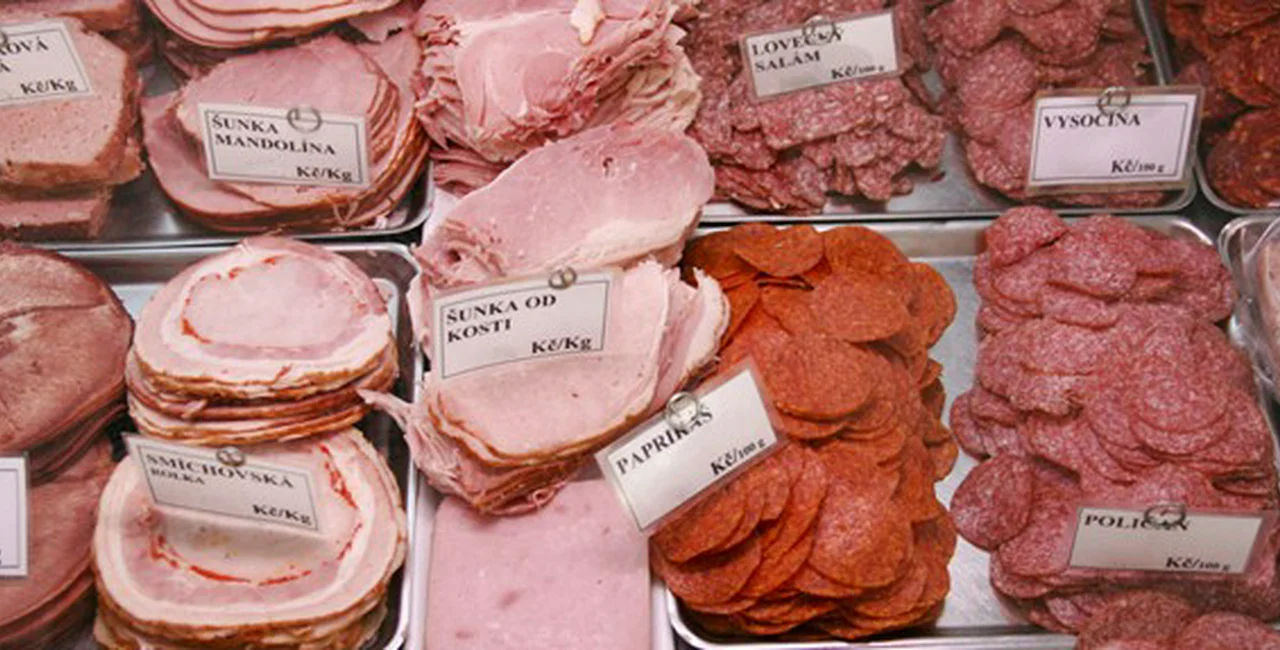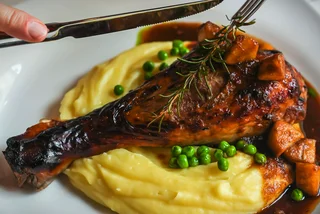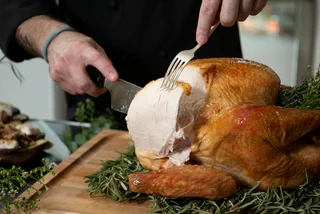Cookouts, fry-ups, camping trips, picnics, or just a good old-fashioned craving for a hot dog; whatever the reason for shopping at the deli counter, you’ll want to know what exactly it is that you can get there.
HAM
The Czech for ham is šunka, and there are quite a number varieties; each is going to differ based on the type as well as the producer. The term refers to both a cured hind leg of pork, as well as pork meat which has been processed in brine and cured in a mold. Here are some of the more common varieties of hams and ham-related products.
- Dušená šunka is a processed ham made from lean pork leg meat pieces cured in brine. Its name means braised or stewed ham because the ham is cooked while processing. As a result, it is usually moist and a little salty.
- Dětská šunka (children’s ham) is similar to the Dušená šunka, only the brine used is milder.
- Šunkové koleno is ham made from the meat around the knee (pork knuckle).
- Debrecinská pečeněis processed ham with ground mild red pepper (sweet paprika powder) on the outside. Its name comes from Debrecen (Debrecín), a town in Hungary.
- Anglická slanina, though meaning English bacon, doesn’t resemble English bacon at all. Anglická slanina is made from pork belly (pork side) and is usually sold in straight strips, smaller than its English counterpart. Also, the bacon doesn’t have the pink ‘head‘ and fatty ‘tail‘ of an English rasher.
- Moravské uzené(Moravian smoked meat) is prepared from pork leg, with a characteristic dark outer layer from the caramel rub.
- Cikánská pečeně is similar to Moravské uzené, except garlic is added to the rub.
- Šunka od kosti,literally ham off the bone, is ham which has been smoked as a whole leg at once. It is not so moist.
- Pršut, can mean any dry-cured fermented ham, such as prosciutto. If region matters to you, ask where the ham was made.
SALAMIS
In this section are the salamis which are usually served cold. They are either processed or fermented.
- Gothaj or Gothajský salám is a light, mild salami, with a somewhat similar appearance and taste to mortadella in that it has pieces of fat throughout. It is made from pork and beef.
- Herkules is fermented salami from pork meat, marbled with fat. For want of a better term, this is a ‘typical’ salami.
- Junior, pronounced Yoo-nyi-or, is basically baloney (or polony).
- Lovecký salám, though called hunter’s salami, contains pork and beef, not game, and is seasoned with pepper with garlic. It has a tangy flavor, hard texture and is easily identified by its rectangular shape.
- Métský salám is unprocessed salami which is smoked ‘cold’ over a few days. It is also a little spicy.
- Paprikáš is a fermented salami with peppers. Paprikový salám is similarly flavored with peppers, but it is processed, not fermented.
- Poličan, like Herkules, is a fermented salami made from pork. Often, the pieces are smaller and the taste is a little milder.
- Točený (točeňák) is any number of soft processed salami, which looks more like a sausage. Common varieties include polský salám (Polish salami), which is made from a mix of pork and beef and can be flavored mildly with garlic or peppers, and koňský salám (horse salami) made from a mix of horse and pork meat. Often točený is available in long pieces, which are cut into the desired amount by the shop assistant. It is quite soft in texture.
- Uherák or uherskýsalám is the Czech term for winter salami. This style of salami is fermented to allow white mold to grow on the outside. This gives the salami a strong flavor.
- Vysočina is a processed salami, which is a more pink than red and has a mild flavor and softer texture.
SAUSAGES
In this group, we have two broad sub-groups: párky, which are similar to frankfurters, and klobásy,which are often thicker fattier sausages. Párky are suitable for steaming, boiling or grilling. Theyare sold in pairs, hence the name (little pairs). A butcher might confirm how many you want by checking if you want one leg (nožička) or two (dvě nožičky).Klobásy are for grilling either on a hotplate, pan, grill, or over an open fire. They are sold individually.
Párky
- Jemné and vídeňské are made from pork, or a mix of beef and pork, with orange-brown skins. Jemné are what you’ve eaten if you’ve ever ordered a hot dog (párek v rohlíku).Videnské (Viennese) tend to have firmer skin and a smoky flavor.
- Debecinské are also similar to the above sausages, only the meat is not ground fine. It is in larger pieces. These sausages are a little spicier.
- Drůbeží are sausages made from poultry.
- Koktejlové are your cocktail franks, which are like the jemný, only shorter.
Klobásy
- Ostravské are made from pork meat with pieces of fat. Their outsides are black from being smoked.
- Pikantní can refer to any number of spicy sausages, usually made from pork and often for sale from fast food stands (občerstvení).
- Domácí just means home-made, so the ingredients will vary depending on the producer. Quite often they are pork sausages.
- Maďarské means Hungarian sausage, though they don’t necessarily come from that country. There can be a number of varieties. Often they are a little drier than the Czech sausages and spicier too.
- Bavorské are bratwurst or at least a Czech variant of if they don’t come from Bavaria. Being white and mild they are a change from the more usually darker heavier sausages on sale.
- Špekáčkyare short fat sausages sold in chains with each individual separated by string. They are made of a mixture of pork and beef, though mostly pork. These sausages are often scored before grilling, preferably over an open fire.
- Vinná klobása are mild delicate sausages, available in long pieces. They are made from pork with a little wine, hence the name. Often they are twirled into a spiral, which is secured with skewers, and then grilled.
“ZABIJAČKA” Specialties
You’ve no doubt heard of the joy of attending a zabijačka. However, you can still try some of the typical dishes without having to be around an animal being killed.
- Jitrnice looks like a sausage, except the ends are tied and held with a small piece of wood. Though they look like a sausage, they are quite different. The contents are a soft mix of jowl, pork belly, offal (especially the liver), white bread, stock, and spices. They need to be cooked slow on a low heat to avoid bursting.
- Jelito is Czech blood sausage. It tends to be softer than the British black pudding. It is filled with barley or buckwheat. Cook as you would jitrnice.
- Tlačenka is translated as ‘headcheese’, but it’s much tastier than it sounds. The light (světlá) version is made from off-cuts of pork meat including offal which is cooked in a stock. The meat and stock mixture is then placed in a bag and allowed to set. The dark (tmavá) variety has blood added. Both are eaten cold with onions and vinegar.
For those who can’t stand the local product or miss home, remember Robertson stocks sausages and, of course, real bacon.
***
Deciphering Czech food products series:
- Dairy – A helpful guide to milk, butter, yogurt, and more..
- Beef Cuts – How to ask for what you need at Czech butcher’s?
- Czech Potatoes – How it Rose from the Underground to Czech Tables Everywhere
- Beer – Czech Beer’s Got Style
- Bread – A guide to bread and other baked goods
- Cold Cuts – We look at ham, sausage and other goodies
- Cheese – Czech (and Slovak) Cheeses
- Flour and other baking products
- Vegetable – We take a stroll through the Czech veggie section
Related articles
- Farewell Fake Rum? A Short History of the Endangered Czech Spirit
- Cocktail Emporium with Prague-Themed Drinks Opens on Wenceslas Square
- Prague Named among Top 10 Vegan-Friendly Capitals In 2017
- Czech Republic Will Continue to Fight Inferior Food Quality
- Take a Look Inside Prague’s New Temple For Meat Lovers












 Reading time: 6 minutes
Reading time: 6 minutes 


 Polish
(Proficient)
Polish
(Proficient)


















